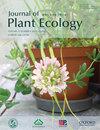Seasonal and diurnal variations in ecosystem respiration and environmental controls from an alpine wetland in arid northwest China
IF 3.9
2区 环境科学与生态学
Q2 ECOLOGY
引用次数: 3
Abstract
Wetlands store large amounts of carbon stocks and are essential in both global carbon cycling and regional ecosystem services. Understanding the dynamics of wetland carbon exchange is crucial for assessing the carbon budgets and predicting their future evolution. Although many studies have been conducted on the effects of climate change on the ecosystem carbon cycle, little is known regarding carbon emissions from the alpine wetlands in arid northwest China. In this study, we used an automatic chamber system (LI-8100A) to measure ecosystem respiration in the Bayinbuluk alpine wetland in arid northwest China. The ER showed a significant bimodal diurnal variation, with peak values appearing at 16:30 and 23:30 (Beijing time, UTC+8). A clear seasonal pattern in ER was observed, with the highest value (19.38 μmol m -2 s -1) occurring in August and the lowest value (0.11 μmol m -2 s -1) occurring in late December. The annual ER in 2018 was 678 g C m -2 and respiration during the non-growing season accounted for 13% of the annual sum. Nonlinear regression revealed that soil temperature at 5 cm depth and soil water content were the main factors controlling the seasonal variations in ER. The diurnal variation in ER was mainly controlled by air temperature and solar radiation. Higher temperature sensitivity (Q10) occurred under conditions of lower soil temperatures and medium SWC (25%≤SWC≤40%). The present study deepens our understanding of CO2 emissions in alpine wetland ecosystems and help evaluate the carbon budget in alpine wetlands in arid regions.西北干旱高寒湿地生态系统呼吸的季节和日变化及环境控制
湿地储存着大量的碳储量,对全球碳循环和区域生态系统服务都至关重要。了解湿地碳交换的动态对于评估碳预算和预测其未来演变至关重要。尽管人们对气候变化对生态系统碳循环的影响进行了许多研究,但对中国西北干旱地区高山湿地的碳排放却知之甚少。在本研究中,我们使用了一个自动室系统(LI-8100A)来测量中国西北干旱地区巴音布鲁克高山湿地的生态系统呼吸。ER表现出显著的双峰日变化,峰值出现在16:30和23:30(北京时间UTC+8)。ER呈明显的季节性变化,最高值(19.38μmol m-2 s-1)出现在8月,最低值(0.11μmol m-2 s-1。2018年的年ER为678g C m-2,非生长季节的呼吸量占全年总量的13%。非线性回归分析表明,5cm深度的土壤温度和土壤含水量是控制ER季节变化的主要因素,ER的日变化主要受气温和太阳辐射的控制。在较低的土壤温度和中等SWC(25%≤SWC≤40%)的条件下,温度敏感性(Q10)较高。本研究加深了我们对高山湿地生态系统中二氧化碳排放的理解,并有助于评估干旱地区高山湿地的碳预算。
本文章由计算机程序翻译,如有差异,请以英文原文为准。
求助全文
约1分钟内获得全文
求助全文
来源期刊

Journal of Plant Ecology
生物-植物科学
CiteScore
4.60
自引率
18.50%
发文量
134
审稿时长
3 months
期刊介绍:
Journal of Plant Ecology (JPE) serves as an important medium for ecologists to present research findings and discuss challenging issues in the broad field of plants and their interactions with biotic and abiotic environment. The JPE will cover all aspects of plant ecology, including plant ecophysiology, population ecology, community ecology, ecosystem ecology and landscape ecology as well as conservation ecology, evolutionary ecology, and theoretical ecology.
 求助内容:
求助内容: 应助结果提醒方式:
应助结果提醒方式:


